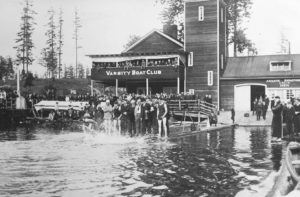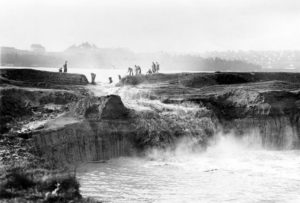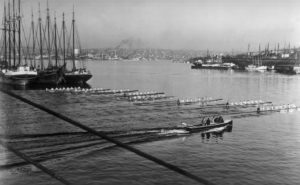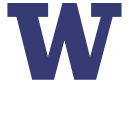On July 9 of this year, the Army Corp of Engineers, in conjunction with a number of historical organizations, will celebrate the 100th Anniversary of the completion of the Lake Washington Ship Canal with a boat parade through the locks and into Lake Union. On hand will be a Washington 8-oared crew, as well as the historical coaching launches The Conny and the Husky II, as Washington Rowing salutes the 100th Anniversary of our home course, the Montlake Cut.
 Initiated in 1909, the 8-year ship canal project itself was a combination of man-made canals linking already existing bodies of water (Lake Washington to Portage Bay; Lake Union to Salmon Bay; then culminating in the 20 foot drop to Puget Sound at the westernmost end now known as the Chittenden Locks). But it was the easternmost canal – the Montlake Cut – that would ultimately have a transformative impact on the sport of rowing at Washington.
Initiated in 1909, the 8-year ship canal project itself was a combination of man-made canals linking already existing bodies of water (Lake Washington to Portage Bay; Lake Union to Salmon Bay; then culminating in the 20 foot drop to Puget Sound at the westernmost end now known as the Chittenden Locks). But it was the easternmost canal – the Montlake Cut – that would ultimately have a transformative impact on the sport of rowing at Washington.
When Europeans first arrived in the region, the area known as the Cut today had been used by Native Americans for portage to Lake Union for centuries. Footworn trails already existed on the narrow, 2,500 foot isthmus between lake Washington and Lake Union. Within a few decades, and as commerce – driven by the logging industry – flourished, creative solutions for moving old-growth timber between waterways were evolving, including troughs, horse drawn sleds, and finally a short railroad. But for Hiram Conibear’s crews – who lived together and trained out of the VBC building on Lake Union – it meant they carried their shells the half mile on dirt paths over to Lake Washington to race.

Finally, with the arrival of Hiram Chittenden in 1907 to lead the Army Corp of Engineers in Seattle, an official plan was put in place to begin digging a canal from Lake Washington to the Sound. But it did not go smoothly. Lake Washington sat nine feet above Portage Bay, and a canal would mean the lake level would drop that distance. Docks, beaches, mills – you name it – would be left high and dry, and by 1910 there were enough lawsuits in place to periodically stop construction completely. But in between court orders, digging would continue, with much of the removed glacial sediment becoming fill on the new UW campus. By 1914, with legal issues behind it, the Cut was fully dug… only to be delayed by voter reluctance to fund the needed foundation for a future Montlake Bridge.
By 1916 – with the public finally approving the needed funds, and concrete lining the banks with fresh new railings along the shore – the Cut was ready. In late August the cofferdams at each end were breached. Over the next few weeks, Lake Washington rushed into Portage Bay and on into Lake Union, ultimately cascading into Puget Sound on the western edge where the Locks were nearing completion. By the fall, the two bodies of water were merged.
For the rowing team at Washington, that connection was transformative. That fall, practice was no longer limited to Lake Union, and opened up significantly longer and more protected areas for distance rowing in Lake Washington. More importantly, as the original VBC building on Portage Bay continued to deteriorate, it led to the opportunity, post WWI, to move into the Navy Seaplane Hangar built on the Cut by the Navy. Ed Leader learned a thing or two from his mentor Hiram Conibear, and as the war ended, quickly moved his team into the empty building on the Cut. For 30 years that building would be the home of the Huskies, generating some of the greatest teams in our history.
For the men and women of Washington today, the Montlake Cut is home. Through the 60’s the Cut was used for the occasional 2,000 meter race; but by the 70’s, with the first “Opening Day” regatta held in 1970, the official home course for the UW would transition from Seward Park to the Cut. It has remained that way now for almost forty years.
 As part of the celebratory boat parade on July 9th, Kirk “Lucky” Knapp has been active in organizing a Washington Rowing contingent for the parade. “I think we would steal the show if we can get Callahan in a fedora in the Conny,” said Lucky, in reference to the common headwear of Al Ulbrickson and the launch – rescued by Lucky 30 years ago – that was Ulbrickson’s on-the-water office for decades.
As part of the celebratory boat parade on July 9th, Kirk “Lucky” Knapp has been active in organizing a Washington Rowing contingent for the parade. “I think we would steal the show if we can get Callahan in a fedora in the Conny,” said Lucky, in reference to the common headwear of Al Ulbrickson and the launch – rescued by Lucky 30 years ago – that was Ulbrickson’s on-the-water office for decades.
Current plans are in the works to row a shell (possibly two) in the boat parade, followed by the Conny and Husky II. Stay tuned to the Washington Rowing Twitter page and our Facebook page as we get closer to July 9th for more details. We hope to see you July 9th as we help celebrate the 100-year anniversary of our home course, the Montlake Cut!
Thank you Jennifer Ott and History Link for providing the bulk of the information and research on the planning and development of the Montlake Cut.
For more information on the Montlake Cut, the Centennial of the ship canal, and the boat parade, visit the website.
Watch a video made for the Centennial, featuring the Windermere Cup and the significance of the Montlake Cut to rowing in Seattle









